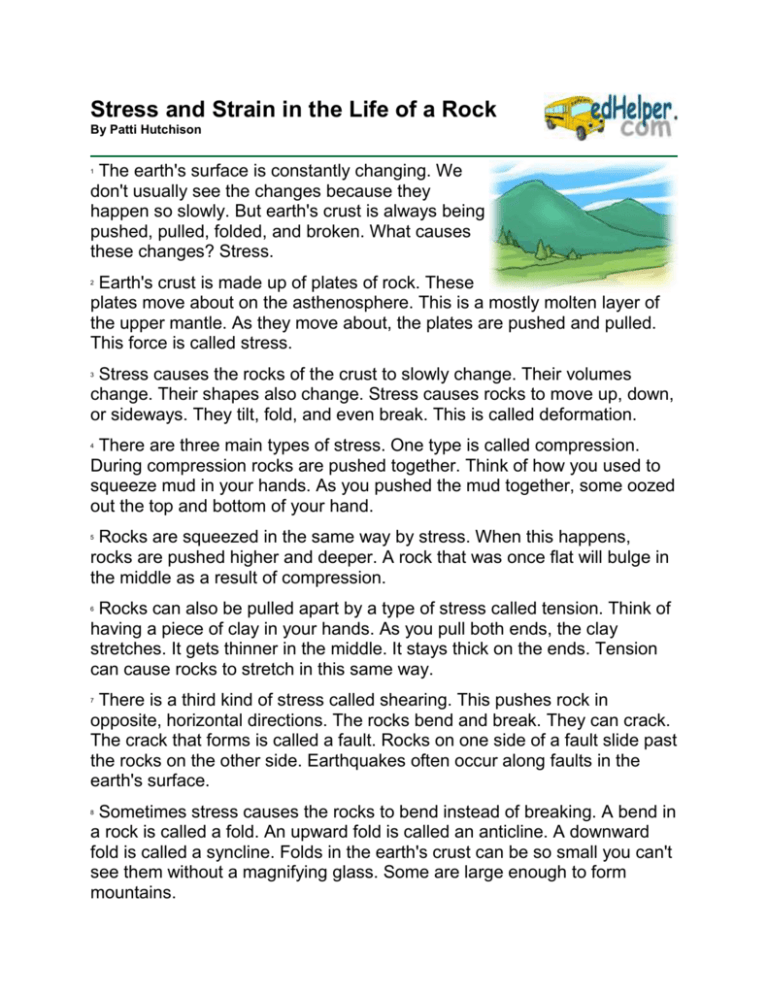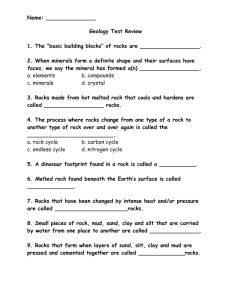Stress and Strain in the Life of a Rock
advertisement

Stress and Strain in the Life of a Rock By Patti Hutchison The earth's surface is constantly changing. We don't usually see the changes because they happen so slowly. But earth's crust is always being pushed, pulled, folded, and broken. What causes these changes? Stress. 1 Earth's crust is made up of plates of rock. These plates move about on the asthenosphere. This is a mostly molten layer of the upper mantle. As they move about, the plates are pushed and pulled. This force is called stress. 2 Stress causes the rocks of the crust to slowly change. Their volumes change. Their shapes also change. Stress causes rocks to move up, down, or sideways. They tilt, fold, and even break. This is called deformation. 3 There are three main types of stress. One type is called compression. During compression rocks are pushed together. Think of how you used to squeeze mud in your hands. As you pushed the mud together, some oozed out the top and bottom of your hand. 4 Rocks are squeezed in the same way by stress. When this happens, rocks are pushed higher and deeper. A rock that was once flat will bulge in the middle as a result of compression. 5 Rocks can also be pulled apart by a type of stress called tension. Think of having a piece of clay in your hands. As you pull both ends, the clay stretches. It gets thinner in the middle. It stays thick on the ends. Tension can cause rocks to stretch in this same way. 6 There is a third kind of stress called shearing. This pushes rock in opposite, horizontal directions. The rocks bend and break. They can crack. The crack that forms is called a fault. Rocks on one side of a fault slide past the rocks on the other side. Earthquakes often occur along faults in the earth's surface. 7 Sometimes stress causes the rocks to bend instead of breaking. A bend in a rock is called a fold. An upward fold is called an anticline. A downward fold is called a syncline. Folds in the earth's crust can be so small you can't see them without a magnifying glass. Some are large enough to form mountains. 8 Why do some rocks fold, and others fault? Many factors affect these actions. One is temperature. Rocks that become very hot during compression usually fold. Higher pressure will also likely cause rocks to fold instead of fault. 9 Some rocks are brittle. They break easily under stress. Others are ductile. This means they bend easily. These rocks are more likely to fold. The way the force is applied to a rock will also determine whether it will fold or fault. If the force is applied quickly, the rock will usually fault. If it is applied slowly, it will likely fold. 10 Stress and strain take a toll on rocks. Pressure caused by the movement of plates changes the earth's crust. These changes usually happen over long periods of time. Just think: some of the mountains you see today were once flat land. The earth looks very different today than it did billions of years ago. 11 Copyright © 2013 edHelper







